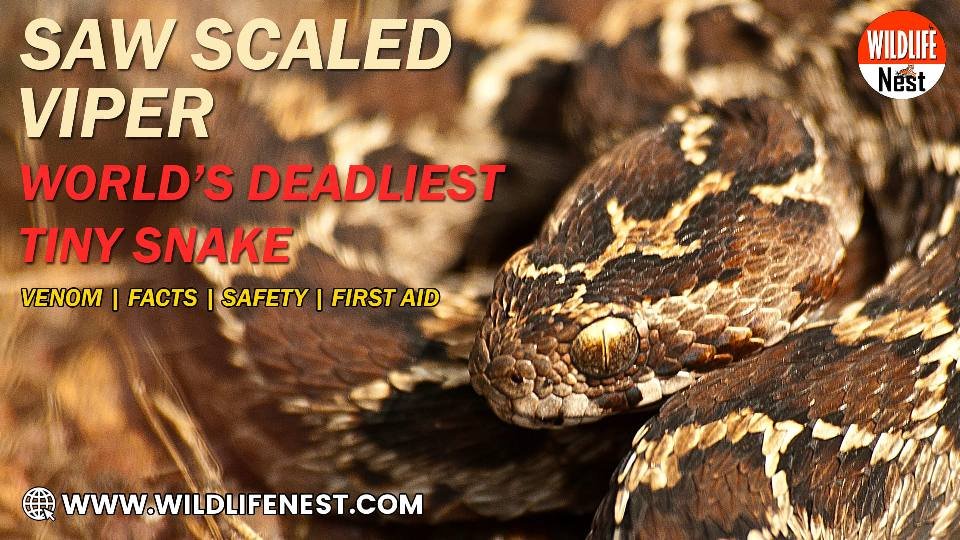Introduction to Saw Scaled Viper Snake
The Saw Scaled Viper, scientifically known as Echis carinatus, is a small but extremely dangerous venomous snake found widely across parts of Asia and the Middle East. This viper is known for its aggressive nature, quick strikes, and a unique rasping sound it produces by rubbing its scales together—an alarming warning to potential threats. Despite its relatively small size, the Saw Scaled Viper is responsible for a large number of snakebite incidents, especially in rural India. Due to its camouflaged body and nocturnal habits, it often goes unnoticed by unsuspecting people walking barefoot in fields or villages. The viper plays a crucial role in the ecosystem by controlling rodent populations, which makes it an important part of natural pest control. However, its presence near human settlements often leads to conflicts. The Saw Scaled Viper is feared not just for its venom, but for its unpredictable and easily provoked behavior, making education and awareness essential in areas where it is commonly found.
Saw Scaled Viper Snake

Species Profile: Saw Scaled Viper Snake
| Attribute | Details |
|---|---|
| Snake Name | Saw Scaled Viper |
| Scientific Name | Echis carinatus |
| WLPA Schedule | Schedule IV (Wildlife Protection Act, India) |
| Regional Names | Hindi: अफई (Aphai) Marathi: फुरसं (Phoorsa), फुरसे, कांडर (Wardha), रक्ती कांबळ्या (North Konkan), आग्या फुरसे (Tal Konkan), रक्ती परड (Vidarbh) Tamil: சுருட்டை விரியன் (Surattai pambu, Viriyan pamboo, Surutai vireyan) Telugu: Chinna pinjara, pinjara Kannada: kallu haavu, garagasa mandala Malayalam: അണലി (Anali), ചുരുട്ടമണ്ഡലി Gujarati: tarachha, zeri padkoo (ઝેરી પૈડકુ), Pendka, udaneyn Sindhi: kuppur, janndi Odia: Dhuli Naga Bengali: ফুরসা বোড়া সাপ (Fursa boda sap), কাঁটা-আঁইশা বোড়া, খুঁদে চন্দ্রবোড়া, বোড়া সাপ, বঙ্করাজ Tulu: ನೆತ್ತೆರ್ ಮೂಗೇಲ್ (Netter mugel) Rajasthani: Bandi Sinhala (Sri Lanka): වැලි පොළඟා (Vali polonga) |
| Physical Description | Small and stocky, 30–80 cm long, rough keeled scales, saw-like flanks, and brown or grey color with wavy patterns. |
| Habitat | Deserts, scrublands, grasslands, agricultural fields, rocky terrains |
| Diet | Rodents, lizards, frogs, and insects |
| Behaviour | Nocturnal, aggressive, uses a sidewinding motion, produces a raspy warning sound |
| Venomous or Non-Venomous | Venomous |
| Venom Type | Hemotoxic |
| Venom Effects on Prey | Rapid tissue damage, hemorrhage, and circulatory collapse |
| Venom Effects on Humans | Severe pain, swelling, blistering, coagulopathy, internal bleeding, kidney failure, can be fatal without treatment |
| Common or Rare | Common in dry and arid regions of India and surrounding countries |
| Life Span | Around 10–12 years in the wild |
| Mating & Reproduction | Oviparous (lays eggs), mating occurs in summer, females lay 6–23 eggs, hatch in 1–2 months |
Introduction to Snakes of Saw Scaled Viper Snake
Snakes, including the Saw Scaled Viper, are fascinating reptiles known for their elongated bodies, absence of limbs, and unique modes of locomotion. The anatomy of snakes is specially adapted to their environments. They possess flexible jaws, allowing them to consume prey much larger than their head. The Saw Scaled Viper, in particular, exhibits a unique adaptation—keeled scales that help in camouflage and produce a defensive rasping sound. Snakes, in general, play an essential ecological role by maintaining the balance in the food chain. They help in controlling populations of pests such as rats and insects, making them beneficial to both agriculture and human health. Unfortunately, many misconceptions surround snakes, including the belief that all are dangerous or evil. In reality, only a small percentage are venomous, and even fewer pose a serious threat to humans. Education and awareness can help eliminate these myths and foster a better understanding of these reptiles. The Saw Scaled Viper, despite being dangerous, contributes to the ecosystem’s health and requires respectful coexistence rather than fear.
| Topic | Details |
| Habitats | Deserts, dry scrublands, rocky hills, sandy soils, agricultural fields |
| Geographical Distribution | Found in India, Pakistan, Sri Lanka, the Middle East, and parts of Africa |
Snake Behaviour
The Saw Scaled Viper displays distinct behavior patterns that reflect both its survival strategies and its adaptability to various environments. It is primarily nocturnal, becoming active during the night when temperatures are cooler. During the daytime, it hides under rocks, debris, or in burrows to avoid heat and predators. When it comes to feeding, this snake primarily hunts rodents, lizards, frogs, and occasionally insects. It uses its highly potent hemotoxic venom to immobilize and digest prey. Its sidewinding motion not only helps it move efficiently across loose sand but also minimizes its contact with hot surfaces in desert areas.
Mating usually takes place during the warmer months, with males often engaging in combat to win a female. The species is oviparous—females lay eggs which hatch after about two months. The young are independent from birth and already venomous. In defense, the Saw Scaled Viper doesn’t hesitate to stand its ground. It coils into an S-shape, rubs its body scales together to produce a raspy sound, and strikes swiftly if threatened. Camouflage and its defensive posture make it both an elusive and dangerous predator. Understanding these behaviors is crucial for minimizing human-snake conflicts.
First Aid and Medical Treatment for Saw Scaled Viper Bites
In the unfortunate event of a Saw Scaled Viper bite, immediate and correct action can save lives. First, the victim should remain calm and avoid moving the affected limb to slow down the spread of venom. Reassure the person and immobilize the bitten area, keeping it at heart level or lower. Do not apply a tourniquet, cut the wound, or attempt to suck out the venom, as these methods can cause more harm than good. Remove tight clothing or jewelry near the bite area in case of swelling.
Transport the victim to the nearest medical facility immediately. Medical professionals may administer anti-venom specific to the Saw Scaled Viper, along with pain relief, antibiotics, and supportive treatments for complications such as bleeding or kidney failure. Time is of the essence—quick medical attention significantly improves survival chances and reduces long-term effects. In areas where this viper is common, awareness about local hospital preparedness and keeping emergency numbers handy is essential for communities.
Global Impact of Saw Scaled Viper Snake Bites
Despite being a small snake, the Saw Scaled Viper has a significant global impact, especially in countries like India, Pakistan, and Sri Lanka. It is one of the leading causes of snakebite deaths in the world, primarily because it often lives near human settlements. Thousands of people—particularly agricultural workers—are bitten each year, and due to delayed treatment or lack of access to healthcare, fatalities are common. The World Health Organization (WHO) classifies the Saw Scaled Viper as one of the most medically important snakes.
Its impact extends beyond public health to economic burdens, with victims often being the sole breadwinners of their families. Hospitals and health systems in rural regions face pressure during the monsoon and harvest seasons when encounters spike. Global snakebite initiatives are working to improve anti-venom availability, training of healthcare workers, and public education to reduce mortality and disability from bites.
If You Encounter a Snake on Your Property
- Remain Calm and Assess the Situation: Panicking can provoke the snake; stay composed and observe from a safe distance.
- Ensure Safety: Keep pets and children away; secure the area and do not try to handle the snake yourself.
- Identify the Snake (If Possible): From a distance, try to observe the color, patterns, and size to help professionals identify it later.
- Contact Professional Help: Call local wildlife rescue or forest department authorities to remove the snake safely.
- Prevent Future Encounters: Keep your yard clean, seal holes and cracks, and avoid leaving food that attracts rodents.
- Educate Yourself and Others: Learn about local snakes and teach your family basic safety tips and first aid procedures.
Tips for Snake Enthusiasts
For those interested in observing snakes like the Saw Scaled Viper in the wild, safety and respect are key. Always maintain a safe distance, use a flashlight during night walks, and wear protective gear such as boots and gloves. Never attempt to handle or provoke a snake, especially venomous ones. Use binoculars or cameras with zoom lenses to enjoy sightings without putting yourself or the animal at risk.
Aspiring herpetologists should study reptile biology, behavior, and ecology through academic programs or internships. Fieldwork experience is invaluable—volunteering with wildlife organizations, contributing to conservation surveys, and learning snake rescue techniques under professionals can boost both skills and credibility. Reading scientific literature, joining herpetology communities, and spreading awareness can also aid in building a knowledgeable and responsible approach toward snake conservation.
Interesting Facts About Saw Scaled Viper Snake
- Scale Music: The viper produces a hissing rasp by rubbing its body scales together—a unique form of sound among snakes known as stridulation.
- World’s Deadliest Tiny Snake: Despite being small, it’s one of the deadliest snakes globally due to the sheer number of human fatalities it causes annually.
- Multiple Species: There are several sub-species of Echis, each adapted to different environments across Africa, the Middle East, and Asia.
- Sidewinding Snake: Like some desert snakes, it uses a sidewinding motion, especially in loose sand, to conserve energy and stay cool.
- Dry Bite Capability: It can deliver a “dry bite,” injecting no venom, mainly as a warning—useful for conserving venom for prey.
- Egg Laying and Care: Though oviparous, females often guard their eggs until hatching, which is unusual among many snake species.
- Heat Sensing Pits: It may lack visible pits like vipers in the Americas, but it still senses vibrations and heat well through ground contact.
- Record Bite Cases: In India alone, this snake contributes to nearly 80% of reported viper bite cases in certain rural areas.
- Highly Camouflaged: Its coloration blends perfectly with gravel and dry leaves, making it hard to spot even at close range.
- Medicinal Research: Components of its venom are studied for developing drugs to treat blood clotting disorders and other medical conditions.
Frequently Asked Questions (FAQ) About Saw Scaled Viper Snake
Q1. Is the Saw Scaled Viper the deadliest snake in the world?
A1. While not the most venomous, it is considered one of the deadliest due to the high number of human fatalities it causes, especially in India.
Q2. How can I identify a Saw Scaled Viper?
A2. It is small (30–80 cm), has rough, keeled scales, a zigzag pattern on its back, and produces a rasping sound when threatened.
Q3. Where is the Saw Scaled Viper commonly found?
A3. It is commonly found in India, Pakistan, Sri Lanka, parts of the Middle East, and some regions in Africa, particularly in dry and arid areas.
Q4. What should I do if bitten by a Saw Scaled Viper?
A4. Stay calm, avoid movement, and seek immediate medical help. Do not use traditional methods like cutting the wound or applying a tourniquet.
Q5. Are all bites from this snake fatal?
A5. No, some bites are dry (non-venomous), and with timely treatment using anti-venom, most people recover fully.
Q6. Why is this snake dangerous to farmers and villagers?
A6. It often lives near agricultural fields and moves during night hours, making barefoot villagers and farmers easy targets for accidental bites.
Q7. Does it have natural predators?
A7. Yes, mongooses, birds of prey, and larger snakes sometimes prey on Saw Scaled Vipers.
Q8. Can its venom be used in medicine?
A8. Yes, its venom is being researched for potential use in blood thinning drugs and treatments for cardiovascular conditions.
Q9. Is it protected under Indian wildlife laws?
A9. Yes, it is listed under Schedule IV of the Indian Wildlife Protection Act, 1972, offering it legal protection.
Q10. How can we avoid snake bites in areas where this viper is common?
A10. Wear shoes while walking in fields, use torches at night, clear vegetation around homes, and educate communities on snakebite prevention.
Watch Wildlife Awareness Videos
For more engaging and educational content on snakes and other wild creatures, don’t forget to visit our official YouTube channel: www.youtube.com/@WildlifeNest
Subscribe and explore fascinating wildlife stories, awareness videos, and rare sightings—all brought to you by Wildlife Nest!
Related Snake Species – Explore More on Wildlife Nest
| Snake Species / Topic | Read Article |
|---|---|
| Indian Rat Snake | Read Article |
| Common Sand Boa Snake | Read Article |
| Indian Rock Python | Read Article |
| Two Step Snake | Read Article |
| King Cobra Secrets – Study Breaks 180 Year Myth | Read Article |
| Slender Coral Snake | Read Article |
| The Green Vine Snake – An In-Depth Look | Read Article |
| Common Cat Snake – All Information | Read Article |
| Banded Krait Snake – All Information | Read Article |
| King Cobra – All Information | Read Article |
| Common Krait – All Information | Read Article |
| Russell’s Viper | Read Article |
| Saw Scaled Viper Snake – All Information | Read Article |
| Cobra Snake – All Information | Read Article |
| The Big Four Snakes of India | Read Article |
| What Are Reptiles? | Read Article |
| The Deadliest Venom | Read Article |
| Most Dangerous Snakes in the World | Read Article |
| The Ultimate Guide to Snakes | Read Article |
| History of Snakes – Evolution, Habitats, Survival | Read Article |


